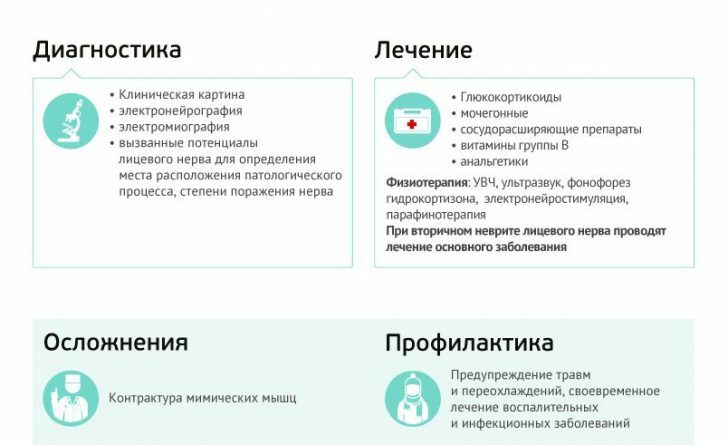Nervous tic of the eye: treatment, symptoms

Nervous tick refers to the type of disease in which a certain group of muscles is contracted. This is a fairly common disease, which is mainly expressed in the face area and represents a variety of combinations of facial movements. Mostly the disease occurs in children, but it can also occur in an adult. The most common disease, more precisely a kind of nervous tic, is the nervous tic of the eye. Everyone faced this phenomenon, because it is very noticeable among the masses of people, when one constantly winks. There are two main types of nervous tics: primary and secondary tics. In the first case, the disease occurs with an autonomic disorder of the nervous system and is a disease that occurs in itself, and in the second case, a nervous tic can occur when the brain processes are disturbed.
Kinds of a nervous tic.
Primary tics are characterized by the fact that they occur in children 5-7 years, as a rule, and continue for a long time. Such a trauma in a child can arise as a result of a great emotional impact on the psyche, such as a strong fright.
Secondary tics occur for other reasons that are directly related to the brain activity of a person. Provoked secondary tick can be a brain trauma, or some kind of head tumor, a violation of metabolism in the body and a violation of metabolism. Viral infection and chronic viral diseases can also cause a nervous tic. Chronic tonsillitis is the main cause in children, which can cause a nervous tic, but in most cases the causes of the appearance of the nervous tic of the eyes remain unknown.
This disease can be expressed both in the movement of a certain group of muscles, and in the chaotic movement of several muscle groups. In the first case, with a localized nervous tic, the patient experiences discomfort and can not control a muscle group that is responsible for contractions around the eyeball, and in the second case, with a generalized nervous tic, the patient is contracting a lot of facial muscles and, possibly, Other muscles of the body. Tick, behind the nature of the contraction of the muscle group, can be divided into simple and complex. With a complex tick of the eye, a double or prolonged contraction is observed, which is accompanied by additional actions as opposed to a simple tick, where the reflex movement of the eye muscle passes only once.
Nervous eye tic: treatment, the symptoms of which we now consider, is a complex disease of the nervous system, in which the patient can not even realize this movement and does not attach much importance to it( especially in the case of children).The only hitch is that this movement causes specific reactions in other people who observe it, so treatment of the disease is no less significant than any other disease.
Symptoms of the disease.
Symptoms of the disease are almost impossible to notice immediately, because the patient does not even feel the symptoms of the disease, and to see the strange behavior of the patient can only be from a third party. Expressed symptoms of the disease in short-term contractions of the muscle group, which seem inexpedient in this situation, then there is a re-contraction of them, which has a periodic character. The nervous tic is very often progressing if a person is subjected to constant nervous breakdown and stress. The tick appears more often and more expressively in cases of physical fatigue of the patient, or at strong relaxation of an organism and on the contrary - it is lowered at an exercise stress. To diagnose and determine a nervous tic, you should contact a neurologist who will conduct the necessary studies to determine the disease precisely as a nervous tic of the eye. Symptoms in this case are judged from different approaches, and the doctor excludes diseases associated with the defeat of certain parts of the brain.
Very often the diagnosis and definition by a doctor of this problem as a disease is extremely necessary, as it is very often to distinguish the disease from dissolute behavior, or a confident muscle contraction is very difficult, which can sometimes lead to very serious consequences. Special treatment of a nervous tic is usually not required, and a nervous tic can pass by itself with time and proper care of the patient, providing him with a relaxed environment for work and leisure.
Treatment of the disease.
Sometimes, to eliminate the nervous tic, the patient is treated with psychotherapy. This is especially useful for children who suffer from this disease. In this case, psychotherapy takes place in a playful form and helps to stabilize the child's morale, thereby stimulating him to forget about the illness, and learn how to control it. Moreover, psychotherapy is put not only to the child, but also to his parents, since the disease is very often passing to puberty of the child and makes more anxiety not for the patient himself but for his parents.
In case the nervous ticle of the eye develops already in an adult person, then it is necessary to use mild sedatives that will at first calm the patient, help him to learn how to analyze his condition in the first days, and soon, as a rule, the usual condition is restored. You can treat the disease and a variety of herbal tinctures with nettles, mint, plantain, which serve as a soothing patient.
Strong anti-nervous tics are not recommended and can be used only after the appointment of the attending physician, as they can contribute to an even greater progression of the disease. That is why the tick of the eye is better treated systematically, gradually reducing the number of drugs to calm the nervous system, more often to remove the patient to fresh air and prolong the patient's sleep for several hours.
Treatment of a patient consists in rest and stress removal, which most often cause such a disease, so rest more, live more calmly and always be healthy!



